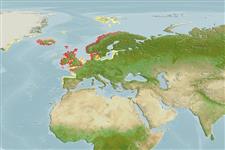Teleostei (teleosts) >
Eupercaria/misc (Various families in series Eupercaria) >
Labridae (Wrasses)
Etymology: Centrolabrus: Greek, kentron = sting + Greek, labros = furious (Ref. 45335).
More on author: Linnaeus.
Environment: milieu / climate zone / depth range / distribution range
Ecology
Marine; reef-associated; depth range 3 - 10 m (Ref. 130218). Temperate; 80°N - 33°N, 47°W - 25°E
Eastern Atlantic: Norway to Portugal; also eastern Greenland.
Size / Weight / Age
Maturity: Lm ? range ? - ? cm
Max length : 18.0 cm TL male/unsexed; (Ref. 4645); common length : 12.0 cm TL male/unsexed; (Ref. 3397); max. reported age: 6 years (Ref. 4792)
Dorsal spines (total): 18 - 20; Dorsal soft rays (total): 5 - 7; Anal spines: 4 - 6; Anal soft rays: 6 - 8. Snout with 5-10 pores. Upper lip with 5-7 folds. Rows of scales on cheek 3-5, on inter-operculum 2 (7-11) scales, on temporo-occipital surface 5-8. Vertebrae 32-34. Preoperculum edge serrated. One row of scales on base of soft part of dorsal and anal fins (Ref. 232). No black spots on the body or fins (Ref. 35388).
Body shape (shape guide): fusiform / normal.
Adults are found in eel-grass beds near rocks. Feed on small invertebrates (Ref. 4742). Eggs are laid in the summer in a seaweed nest (Ref. 35388). Males grow faster than females (Ref. 4792). Oviparous, distinct pairing during breeding (Ref. 205). Used in salmon culture as cleaner fish (Helmut Tethmeyer, pers. comm.).
Life cycle and mating behavior
Maturity | Reproduction | Spawning | Eggs | Fecundity | Larvae
Oviparous, distinct pairing during breeding (Ref. 205). Males build dish shaped nests and guard the eggs (Ref. 205). Also Ref. 103751.
Quignard, J.-P. and A. Pras, 1986. Labridae. p. 919-942. In P.J.P. Whitehead, M.-L. Bauchot, J.-C. Hureau, J. Nielsen and E. Tortonese (eds.) Fishes of the north-eastern Atlantic and the Mediterranean. UNESCO, Paris. Vol. 2. (Ref. 4742)
IUCN Red List Status (Ref. 130435: Version 2025-1)
Threat to humans
Harmless
Human uses
Fisheries: of no interest; aquarium: public aquariums
Tools
Special reports
Download XML
Internet sources
Estimates based on models
Preferred temperature (Ref.
123201): 8.9 - 13, mean 10.7 °C (based on 352 cells).
Phylogenetic diversity index (Ref.
82804): PD
50 = 0.7500 [Uniqueness, from 0.5 = low to 2.0 = high].
Bayesian length-weight: a=0.00741 (0.00462 - 0.01191), b=3.09 (2.96 - 3.22), in cm total length, based on LWR estimates for this species & (Sub)family-body (Ref.
93245).
Trophic level (Ref.
69278): 3.5 ±0.50 se; based on food items.
Resilience (Ref.
120179): Medium, minimum population doubling time 1.4 - 4.4 years (K=0.69-0.81; tmax=6).
Fishing Vulnerability (Ref.
59153): Low vulnerability (20 of 100).
🛈
Nutrients (Ref.
124155): Calcium = 29.2 [12.2, 57.3] mg/100g; Iron = 0.262 [0.139, 0.577] mg/100g; Protein = 18.9 [15.9, 21.1] %; Omega3 = 0.392 [0.200, 0.784] g/100g; Selenium = 5.61 [2.42, 13.29] μg/100g; VitaminA = 75.5 [17.9, 378.5] μg/100g; Zinc = 0.799 [0.513, 1.451] mg/100g (wet weight);
